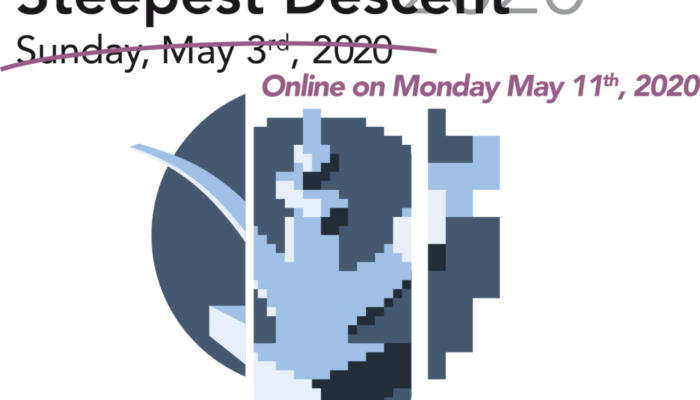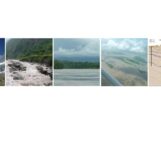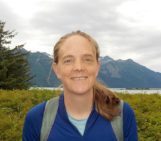
The Steepest Descent is a yearly one-day meeting taking place in Vienna, Austria, close to the EGU general assembly. Participants have the opportunity to see a few keynote talks by outstanding geomorphologists and to discuss their posters in a more informal and geomorphology-focused community than at the EGU.
Despite its youth, the Steepest Descent Meeting seems to have lost its aura of a niche-event, and it may already be considered as a must for our community. In the team of GM ECS representatives, we thought we would ask the organizers themselves about the past, present and future of this well-appreciated geomorphology meeting.
All questions have been answered by Luca Malatesta, on behalf of the entire team.
– The GM ECS Reps team –
Let’s start with some history. When was the Steepest Descent Meeting born? What was the background, and who were the founders?
The first edition was organised in 2013 by Sébastien Castelltort, Jean-Daniel Champagnac, Frédéric Herman, and Niels Hovius. The idea was to emulate the community building role of Gilbert Club after the AGU Fall Meeting. European geomorphologists who were not regularly attending AGU, especially students, were missing out on what has become an important date on the calendar. Once the first few meetings were organized and the concept seemed to work, the original members left and a new team that changes a bit each year progressively took over. In 2020, SDM was organized by Georgie Bennett, Eric Deal, Lizzie Dingle, Erica Erlanger, Laure Guerit, Ugo Nanni, Günther Prasicek, Pierre Valla, Stephen Watkins, and myself.
What are the main differences between the Gilbert Club meeting and the SDM?
The overarching goal of the two meetings is largely the same. Over the years we progressively modified SDM to a format better adapted to our practical needs whilst keeping the same goal. Mainly, we are now committed to an event on the Sunday afternoon immediately before EGU. This is a more family friendly time slot for us as people tend to travel that day anyway and they can go back home on Friday afternoon at the end of EGU. We also try to keep a shorter and tighter schedule than Gilbert Club. Another difference is that after trying a few times, we gave up on pop-up presentations. There was very little interest in the format.
The number of participants have been constantly rising since the beginning, do you think this simply reflects the growth of EGU, or did this have other reasons?
It grew quite fast at the beginning but we have seen a stabilization around 80-110 people in the last years. Participants tend to be early to very early career scientists so I think that the growth mainly reflects the word spreading among students and postdocs. Meanwhile we probably also saw an effect of the growth of the Geomorphology Division within EGU. This year we had up to 310 participants in the webinar, this was in large part colleagues from North America who do not usually come to EGU.
The EGU conveners’ party used to be a lot wilder a few years ago. How did the team manage to run the meeting in the morning right after? May this be the main reason why the event was moved to the day before the EGU annual meeting starts?
On Saturday at 9, it was relatively easy to figure out who had left the party early and who had not. However, regardless of the team’s nightlife that never caused a problem. I personally was initially reluctant to move the meeting on pre-EGU Sunday because I liked the idea of catching up after the main meeting to see all the posters we missed. I was convinced otherwise by other team members and I think that the change was a great call.
Change of topic: what has been the most difficult aspect of the meeting to organize?
One of the main difficulties is quite mundane: planning the catering without knowing exactly how many mouths to feed and how much money we will have. Otherwise, we have the same challenge that any volunteer organisation faces: how to keep momentum and get things going when we do not have formal work duties and all of us cannot always be sure to be at EGU.
Is the Steepest Descent an informal organisation, or did the recent growth push you to enter the happy world of bureaucracy?
We are still an informal setup. I failed to establish an association last year as I had planned. It would have the advantage of improving the sustainability of our work. I worry about losing a lot of organizational knowledge if there is an important team turnover from one year to the next.
How are the SDM speakers chosen? Do you have a long list of people you draw from? Or perhaps decisions are taken based on the hottest topics of geomorphology?
Members of the team start by writing down a lot of names that we would love to hear from (maybe 20 names total). Then everyone gives their preference by distributing a range of points. Once we identify consensual favourites, we start to think of what would make a good and diverse lineup in terms of science, speakers, career stages etc. These last years we put our thumbs on the scale to favour younger speakers. Then we reach out to the top names and see if they would accept. In terms of topics we try to cover a large field from cryosphere to planetary geomorphology, via geochemistry and landscape evolution modelling. It is also a nice opportunity to invite someone external to the field who can give us a keynote on a different topic. For example, I was particularly happy that Prof. Isabel Montañez had accepted our invitation to come talk about the Late Paleozoic Deglaciation in 2018. It was an awesome talk.
How long in advance do you start planning?
Always too late, often the first emails start to be exchanged four-five months before EGU. Once a team is assembled (based on the previous year’s composition and whoever wanted to join us), we forget about it for a while and then rush back to planning once we realize that we are running late.
The current situation of global uprisings against systemic prejudices and discrimination have posed questions on genuine inclusivity and diversity. In your view, how would you suggest SDM addresses these highly topical and relevant concerns?
SDM is a very small outfit compared to EGU and other societies. But this comes with the advantage of being nimble and able to change quickly. At the moment, one of the best things we can do is organizing a meeting that tries to give a platform to excellent scientists representing the existing diversity of the field. It is really not difficult to have a balanced gender ratio in the speaker’s list (since 2013 F/M ratio is 0.7, and 1.1 for the last five editions), especially when two out of three are at an early career stage. We are however not doing a good job when it comes to include and promote BAME speakers and having a diverse team in this respect. It will be important in the future to keep rotating members of the team and integrate early and very early career people in the team.
This year’s edition has been online for obvious reasons. Did this go well, which problems did you encounter? Which feedback did you get from the participants?
It went surprisingly well. First and foremost because the speakers, Vivi Pedersen, Maarten Lupker, and Noah Finnegan embraced the challenge and did a fantastic job presenting and engaging with the audience’s questions. The feedback was largely positive and we agreed with many of the negative points raised (e.g. not enough time between talks and a messy Q&A system). One just needs to look past the occasional “it would be better if it was in person” comments.
Do you think the SDM should keep streaming live also in the coming years?
We had the plan to do a livestream this year as well, following the example set by the SZ4D meetings and seminar series. In the end we were precipitated in that direction, but yes, we will keep a streaming component. It will be an interesting challenge to blend online and onsite audience and to make it a valuable experience for everyone, including the speaker.
Apart from this, are you planning something new for the future events?
We may try to use a better system for questions. We received good feedback about the possibility of asking anonymous questions and the possibility of upvoting current questions. This has a good potential for empowering participation and could also be used on site as a complement to raising hands. This year more than half of the audience found it “easier to ask questions [online] than during an in person meeting.” Meanwhile 32% found it was easier to ask questions with the anonymous option, 7% found it was not easier, and 61% thought it made no difference. This is from a voluntary survey of the participants (144 answers, ie. ca. 37% of total participants) this year.
Although it was online at a time at least partly doable in many time zones, we did not have many participants who do not (cannot) attend EGU normally. Most of the audience regularly attended international meetings in the last years including Gilbert Club and/or SDM. We should do a better job at outreach if we want to grow the community beyond its mainly transatlantic identity.
How do you finance this event?
We are fully funded by the audience and we wish to keep this independence. We sell tickets every year to cover the costs of the event space and the catering. It is always challenging to find the right price for the ticket because we don’t know exactly how many people attend. We erred on the cautious side in the past years and had a small buffer that allowed us to offer this year’s meeting for free (the total cost was low though).
What would be the biggest advice you would give someone who wants to start their own conference?
I think that moving to virtual meetings has been a steep learning curve for many, but we are somewhat trained, if tired, now. It might be reasonably feasible to create new conferences online. Without the heaviness of ground logistics, one can be much more imaginative for new formats and I look forward to seeing people come up with better and better solutions. So the best advice is maybe to just try and be ready to change radically if it does not work. No one can hear you sob in an empty zoom room.
The GM ECS Reps team thanks Luca for his time and engagement.


